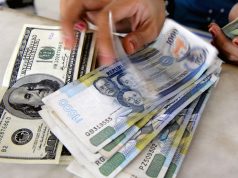AMRO slashes GDP growth forecast for PHL

By Beatrice M. Laforga, Reporter
THE ASEAN+3 Macroeconomic Research Office (AMRO) on Friday slashed its 2020 gross domestic product (GDP) growth forecast for the Philippines to 0.2%, warning that containing the virus should be the country’s top priority as second wave of infections could lead to bigger toll on the economy.
In a note released to journalists, AMRO forecasts showed the Philippines will grow by 0.2% this year, drastically lower than the 4.5% projection given on April 7 during its ASEAN+3 Regional Economic Outlook (AREO 2020) launch, and the 6.2% penciled in March.
The growth projection for the Philippines is at par with the 0.2% average for the ASEAN+3 region, which has also been downgraded from the previous forecast of two percent.
AMRO Chief Economist Dr. Hoe Ee Khor told BusinessWorld that the “probability of a recession is not ruled out” for the Philippines this year amid an unprecedented global slowdown due to the coronavirus pandemic.
Philippines is among the seven Asian countries projected to have a positive growth this year along with China, Brunei, Indonesia, Lao PDR, Myanmar and Vietnam. Meanwhile, AMRO expects full-year contraction for Hong Kong, Japan, Korea, Cambodia, Malaysia, Singapore and Thailand.
For 2021, AMRO sees the Philippine economy expanding by 7.4%, higher than the 6.7% it gave in the AREO and the 6.6% forecast given in March. This is also faster than the estimated 6.2% expansion for the region next year.
“The biggest risk to the Philippine economy now is the COVID-19 pandemic and the fallout from the containment measures… The Philippines has implemented lockdown and strict social distancing policies. This has led to a sudden drop in economic activity which poses some challenges to the Philippines,” Mr. Khor said in an e-mailed response to BusinessWorld‘s questions.
He also said they expect “unemployment to be high” in the Philippines as lockdown measures and downturn in global economy could have a “significant” impact to the labor market in the short term.
In a separate interview with ABS-CBN News Channel, Mr. Khor said the growth projections for the Philippines are unlikely to be revised due to the extension of the enhanced community quarantine for Metro Manila and some regions until May 15.
“We are concerned about a second wave of infection. If that happens, we will review the forecast again,” he said.
Mr. Khor said the Philippines should focus on containing the virus first and bringing the infection rate to lower levels before opening up the economy again. He noted prematurely lifting the lockdown may cause a second outbreak and lockdown, which may prove to be costlier for the economy.
“Countries should focus on containing the virus first. The Philippines has been quite successful in containing the virus. The infection has peaked but the number of infections is not coming down fast enough. The experience of China and Korea show that the virus can be contained. But we have to be patient and strict with the containment measures,” he said.
As of Friday afternoon, the Health department reported total deaths due to COVID-19 reached 477, while infections stood at 7,192. Total recoveries are now at 762.
For the region, Mr. Khor said countries in ASEAN+3 were able to “manage the crisis well” due to strong economic fundamentals.
“ASEAN+3 countries are keen to open up (trade and keep cooperation robust). The only reason slowing them down in opening up is the risk of a second wave of infections. This is the only uncertainty we see,” he said.
According to Mr. Khor, there should be mass testing, contact-tracing and quarantine protocols to bring the infection rate down.
The National Economic and Development (NEDA) said they are still “calculating” the economic impact of the 15-day lockdown extension for high risk areas, including Metro Manila.
In an economic research note, Union Bank of the Philippines Economic Research Unit (ERU) said it projects GDP growth to settle at 0.7% this year if some parts of Luzon is still under ECQ while others under general community quarantine until August.
For the worst-case scenario, however, ERU projects the economy to contract by 3.4% this year, assuming that the “return to normalcy is hinged on the availability of an effective anti-viral treatment,” drug or a working vaccine against COVID-19.
“ERU sees Q1 GDP 2020 growth at 4.5%. The Taal eruption last January and the COVID-19 pandemic’s initial impact in last half of March are considered to be the main drivers of Q1 potential growth level. ERU maintains that Q2 will be negative growth due to the collapse of domestic demand and investments,” the note read.
Other organizations have sashed their growth forecasts for the Philippines as well, including World Bank (3% from 3.2% previously), Asian Development Bank (2% from 6.2%) and International Monetary Fund with (0.6% from 6.3%).



